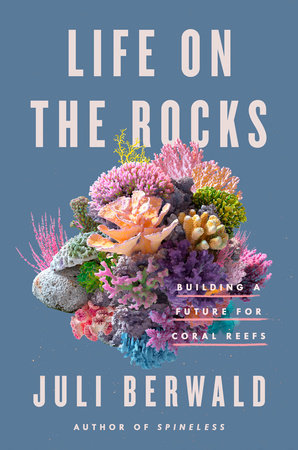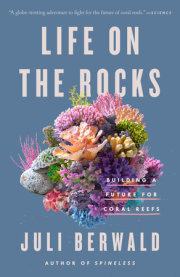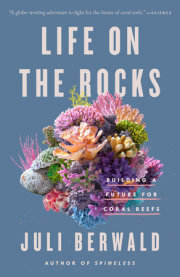1
Fairy Land of Fact
It was love at first sight, for my part anyway. I'm pretty confident the corals felt nothing more than the waft of a current rolling off my flapping fins as I struggled to control my movements. But from the moment I dipped my eyes beneath the surface of the balmy Red Sea and kicked a few meters out to the reef, I was smitten. I had entered a world in which the sea gods and goddesses had conspired to mastermind a magnificent playground and then outfitted it in extraordinary decor. Awash in color and texture, the reef was beyond Baroque, more complex than Gothic. It was floral, it was animal, and it was mineral too. Each delicate petal and tendril was a revelation; each filigree and lattice an astonishment. It wasn't just my ineptness with a snorkel that literally choked me up. I felt emotional, overwhelmed by the simple recognition that this coral reef existed on the same planet as me.
What really made the reef so resplendent was that there was no sea divinity behind its magnificence. It was, as William Saville-Kent, the Great Barrier Reef's first Western biographer, wrote in 1893, a "fairy land of fact." The fairyland was the accumulated work over the eons of hundreds of thousands of tiny animals—most no bigger than the tip of a pencil—and the symbiotic algae that lived tattooed in their tissue. These creatures had none of the organs that we recognize as animal-like, no limbs or eyes or even brains with which to concoct this symphony of splendor. And yet, they had extraordinary capabilities. They were architects who designed the intricate structures of the reef. They were manufacturers who created the rock scaffolding of their homes. They were chemists that made their own protective sunscreen and complicated venoms. They were entrepreneurs who traded in the currency of nitrogen and carbon. They were soldiers who defended their territory from encroaching parties by firing poison-laden darts with unparalleled speed. They were hunters who used those very same extraordinary weapons to sustain themselves.
What was even more inconceivable was that these tiny beings were so much more than just their individual powers. And it was for the collective that my admiration of corals blossomed into true love. They were generous, sharing their nutrition with their neighbors through stomachs that were physically connected together. They were hospitable, building caves and dens for fish and crabs and octopuses and sponges. They were sensual. In the light of the moon, they spawned as one, releasing eggs and sperm upward in a deluge of synchronized hope for the future.
In the years following that first amorous dive on the reef, I changed my life in very significant ways, as one does for a true love. As often happens with passion, it didn't always go smoothly. But after many missteps, I did go to graduate school to study marine biology. Once there, I signed up for every chance I could to dive on other reefs: the Great Barrier Reef in Australia, and on the reefs surrounding Bora Bora, Jamaica, Maui, and the tip of Baja California. When I tucked my head underwater, the rush of love for the coral reef would always wash over me. Again and again, I was enthralled and entranced by the corals, by their creativity and synergy, by their beauty and complexity.
Until I wasn't.
More than a decade ago, I fell off the academic path and slipped into a career as a freelance science writer mostly working on textbooks, although I occasionally wrote for magazines and websites. My grandmother, who was in her midnineties, decided to throw a big party for herself because, as she wisely recognized, "you can't take it with you." She invited our extended family to join her on a Caribbean cruise. While I knew this voyage would be different from sailing on a research vessel, I was eager to see the vast horizon again and for the chance to dive beneath the turquoise waters in the Bahamas and swim around the coral gardens. This cruise company owned an entire island there and we were promised a day of snorkeling.
Aside from being at sea, the cruise was, as expected, strikingly different from life on a research vessel. On scientific cruises, work continued around the clock, which usually meant no more than a few hours of sleep at a time and a constant feeling of grogginess. Here, the ship's staff built a schedule to maximize our enjoyment of various shore activities. We sailed at night, rocked to sleep by the gentle roll of the waves, and awoke to a fresh new vista ripe for adventure each morning. The day we docked on the private island, I pulled back the blinds to the sight of a stunning double rainbow that ended at the beach. How they managed that feat, I had no idea.
The cruise company had thoughtfully supplied rugged wheelchairs with dune-buggy tires, so we could wheel my grandmother down to the beach and into the shallows. Once buoyant in the tepid water, she felt a freedom and lightness that age had stolen from her, and threw her hands in the air in happiness. As I held my toddler-aged daughter, Isy (short for Isabelle), in my arms, we bobbed around our matriarch in a kind of familial dance, basking in the sun and splash.
Afterward, while Isy dug holes in the sandy beach with her cousins, I collected my mask and snorkel to explore the reef. As the water deepened, I started to see small collections of silvery fish, dashing back and forth in the surge. But when I swam closer, I noticed that their scales were damaged and cloudy. Some even had blistery sores, open wounds on their flanks. As I reached the reef itself, if you could call it that, I saw only broken and displaced piles of rubble. Brown strands of slime streamed out from what used to be branches and boughs. As I swam on, I noticed absence. There were no urchins, no sea stars, no tubeworms, not even sponges. I didn't see shrimp crawling on surfaces. I didn't see crabs or snails crawling into crevasses. I looked under an overhang, where I expected to see a few squirrelfish—crimson red, big eyed, and antsy—dart away. The cave was barren. Snotty algae grew everywhere like hunks of moldy carpet. I lifted my head above the water, not wanting to see any more. It was disgusting down there. Rather than a riot of color and texture of life and diversity, it was all slime and decay. I felt dirty.
I knew that the constant pressure of hundreds of cruise passengers every week would take its toll on coral health and that the region had suffered hurricanes. I was also aware that coral reefs were in failing health around the world. I'd read about bleaching and even written about spreading coral disease. But I hadn't experienced the rot and ruin until that day. I didn't know what a dead reef felt like.
The truth is, there's no pot of gold at the end of the rainbow because there is no end of the rainbow. The drops of water in the sky bend and reflect sunlight to form a complete multicolored circle. You have to have perspective to see the full rainbow. You have to get up high. A few mountain climbers and pilots have been able to take pictures of the circular rainbow. Most of the time, we are too close to the ground to see it; most of it remains invisible. But if we could have that perspective, we'd see that, like so many things, the rainbow always returns back to where it started. I should have never expected that the reef beneath that cruise ship would end in a pot of gold. But it did bring me back to where I started.
A dead coral reef isn't a rarity. Today's coral reefs are assaulted by a host of environmental stresses. The largest is climate change, which is warming marine ecosystems even faster than those on land. Tropical corals are the only corals that build extensive limestone reefs, but those tropical corals live uncomfortably close to their upper temperature limit. When they overheat, the algae that live within their tissues knock on the thermostat and, finding no relief, submit their notice of resignation. Or maybe the corals lay them off (much more on that to come). Sometimes corals and algae recover from this breakup-what has come to be known as bleaching—but often they can't. Seventy-five percent of the reef-building corals in the world have already been damaged by high seawater temperatures, which are on average 0.8 degrees C (1.4 degrees F) warmer now than in the twentieth century. Many have not recovered and are already dead. Half the Great Barrier Reef's corals have already died. For most, another degree warmer could be fatal.
The extra carbon dioxide we're adding to our atmosphere by burning fossil fuels doesn't just heat the air and water. When it mixes with ocean waters, it also lowers the water's pH, pushing the seas toward more acidic conditions. While the pH isn't yet low enough to dissolve coral skeletons, it is predicted to reach that threshold by 2085, if not before. How corals will respond is critical to their survival. Then there's overfishing, sedimentation from coastal erosion, ship anchors leaving scars, pollution from pesticide runoff and untreated sewage, unrelenting oil spills, and ever larger hurricanes. It's such a treacherous world for corals today that there are very serious predictions from very serious scientists that the world's great coral reefs may not exist by 2050.
What's at risk? A lot. While coral reefs take up less than 1 percent of the ocean's area, a fourth of all marine species depend on the reef at some point in their lives. A billion people rely on those ecosystems for sustenance or work. The combined revenue from food, recreation, and protection from storms attributed to coral reefs has been calculated at between $2.7 and $10 trillion a year. The death of the reefs means food insecurity for tens of millions. Corals are the most effective buffer known between the land and the sea, diffusing 97 percent of wave energy. A recent study by the U.S. Geological Survey valued the flood protection from coral barriers for U.S. citizens at more than $1.8 billion annually. Globally, the number increases to $9 billion. And that doesn't include their cultural significance or the yet-to-be discovered medicinal cures on the reef. That doesn't even include the joy of diving on coral reefs and celebrating their extraordinary beauty and diversity. But even more than all of that, the very idea that we might extinguish one of the major and most vibrant ecosystems on earth, that we might reduce hundreds of millions of years of evolution and tens of thousands of species to rubble, means we have a moral obligation to look with open eyes at what we've done and what we're doing. Given these dire predictions about coral's future, it seems to some that the only story left to write about the reefs is an obituary. But that's not just premature; it diminishes the story of coral to a quick headline. The ancient oath to love is "in sickness and in health," and so I resolved to look at the coral's sickness and see if I could find examples of healing. In September 2018, I put a Google alert on my email for the daily roundup of "coral reef" news.
Around the same time, I found that it was impossible to contemplate the sickness on the reef without also considering the growing sickness in another of my loves, this one in my own home. During eighth grade, my daughter, Isy, changed in ways that were unexpected and frightening. She'd always been a kid with many friends, but about halfway through the school year, Isy abruptly distanced herself from them all. Snooping on her cell phone, I saw bubble after bubble of unreturned texts. She didn't respond to jokes. She ignored requests to hang out. She blew off invitations for sleepovers. When her friends resorted to the ancient form of communication, telephone calls, she didn't pick up. She brushed off my questions with a new defensiveness in her voice that I couldn't manage to circumvent. At the same time, Isy was spending more time in the bathroom. Within a few weeks, I noticed a line at her wrists, a demarcation between healthy skin and skin dried and tortured from repeated handwashing. Academically, problems were growing too. I saw missing grades in the online gradebook. I'd watch her do homework, but the teachers marked zeros--they said they'd never received her work. She'd study for tests but fail them, and not just a little. A 20 percent wasn't unusual. Her shame and frustration at this new person she was becoming was palpable. At one point, as I sat next to her at the dining room table while she struggled to write an essay on To Kill a Mockingbird, she'd yelled, "I just want it off me!" She collapsed on the floor, waving her arms around as if taking off an invisible coat. I was filled with horror and a sense of powerlessness.
Not long after I set up the "coral reefs" Google alerts, an announcement for a meeting in Florida called Reef Futures rolled into my feed. It was billed as not just about coral biology or about ideas for conserving the reef but for restoring it. Reef restoration was similar in theory to restoring an old home, but with coral colonies as the bricks and planks. When a reef was in disarray, people were learning to actively grow and then plant corals, refurbishing the undersea rather than just waiting for time and nature to fill in the void with a new life--as has been the practice espoused for decades by conservationists. This kind of rebuilding nature has ethical baggage associated with it, starting with the human hubris to think we can do it; passing through What if we muck it up worse? and skirting the corner of Can we really make a difference? and finally landing on Is it worth the cost?
I occasionally checked the Reef Futures 2018 program as new speakers were added. One day, I recognized the name of an Australian scientist named Daniel Harrison. I had a loose connection to Dan because he had worked in the same lab where I did my PhD. We were, as scientists sometimes say, academic siblings. Like me, Dan wasn't a coral biologist, and his talk wasn't directly about coral. It was about the coral's underlying problem: the warming climate. And he was proposing an audacious idea. Dan was slated to talk about building an ecosystem-scale air conditioner to lower the temperature of the ocean around the Great Barrier Reef. The idea belonged in a field known as geoengineering. Geoengineering ideas weren't new, but they have long been considered last-ditch efforts, ideas no one would seriously consider unless we had to. Were we at that point?
Copyright © 2022 by Juli Berwald. All rights reserved. No part of this excerpt may be reproduced or reprinted without permission in writing from the publisher.









